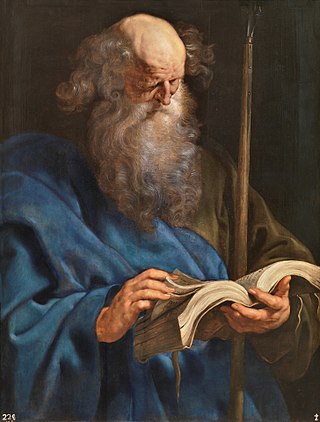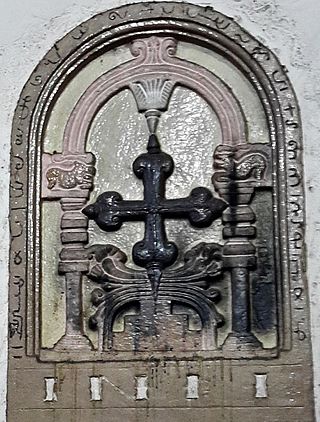
Agnes of Rome is a virgin martyr, venerated as a saint in the Catholic Church, Oriental Orthodox Church and the Eastern Orthodox Church, as well as the Anglican Communion and Lutheran Churches. She is one of several virgin martyrs commemorated by name in the Canon of the Mass, and one of many Christians martyred during the reign of the Roman emperor Diocletian.

Thomas the Apostle, also known as Didymus, was one of the Twelve Apostles of Jesus according to the New Testament. Thomas is commonly known as "Doubting Thomas" because he initially doubted the resurrection of Jesus Christ when he was told of it ; he later confessed his faith on seeing the places where the wounds had healed on the holy body of Jesus after the Crucifixion of Jesus. While it is often assumed he touched the wounds in art and poetry, the scriptures do not say that he touched the wounds.

Eastern Christianity comprises Christian traditions and church families that originally developed during classical and late antiquity in the Eastern Mediterranean region or locations further east, south or north. The term does not describe a single communion or religious denomination. Eastern Christianity is a category distinguished from Western Christianity, which is composed of those Christian traditions and churches that originally developed further west.

The Syriac Orthodox Church, also known as West Syriac Church or West Syrian Church, officially known as the Syriac Orthodox Patriarchate of Antioch and All the East, and informally as the Jacobite Church, is an Oriental Orthodox church that branched from the Church of Antioch. The bishop of Antioch, known as the patriarch, heads the church and possesses apostolic succession through Saint Peter, according to sacred tradition. The church upholds Miaphysite doctrine in Christology, and employs the Liturgy of Saint James, associated with James the Just. Classical Syriac is the official and liturgical language of the church.

The Saint Thomas Christians, also called Syrian Christians of India, Marthoma Suriyani Nasrani, Malankara Nasrani, or Nasrani Mappila, are an Indo-Aryan, ethno-religious community of Indian Christians in the state of Kerala, who, for the most part, employ the Eastern and Western liturgical rites of Syriac Christianity. They trace their origins to the evangelistic activity of Thomas the Apostle in the 1st century. The Saint Thomas Christians had been historically a part of the hierarchy of the Church of the East but are now divided into several different Eastern Catholic, Oriental Orthodox, Protestant, and independent bodies, each with their own liturgies and traditions. They are Keralites and speak Malayalam. Nasrani or Nazarene is a Syriac term for Christians, who were among the first converts to Christianity in the Near East.
Gregory Bar Hebraeus, known by his Syriac ancestral surname as Barebraya or Barebroyo, in Arabic sources by his kunya Abu'l-Faraj, and his Latinized name Abulpharagius in the Latin West, was a Maphrian of the Syriac Orthodox Church from 1264 to 1286. He was a prominent writer, who created various works in the fields of Christian theology, philosophy, history, linguistics, and poetry. For his contributions to the development of Syriac literature, has been praised as one of the most learned and versatile writers among Syriac Orthodox Christians.

Syriac Christianity is a branch of Eastern Christianity of which formative theological writings and traditional liturgies are expressed in the Classical Syriac language, a variation of the old Aramaic language. In a wider sense, the term can also refer to Aramaic Christianity in general, thus encompassing all Christian traditions that are based on liturgical uses of Aramaic language and its variations, both historical and modern.

Araden is a village in Dohuk Governorate in Kurdistan Region, Iraq. It is located in the Sapna valley in the Bamarni Sub-District of Amadiya District.

The Malabar Independent Syrian Church (MISC) also known as the Thozhiyur Church, is a Christian church centred in Kerala, India. It is one of the churches of the Saint Thomas Christian community, which traces its origins to the evangelical activity of Thomas the Apostle in the 1st century.

Antiochene Rite also known as Antiochian Rite refers to the family of liturgies originally used by the patriarch of Antioch.

The East Syriac Rite, or East Syrian Rite, is an Eastern Christian liturgical rite that employs the Divine Liturgy of Saints Addai and Mari and utilizes the East Syriac dialect as its liturgical language. It is one of the two main liturgical rites of Syriac Christianity, along with the West Syriac Rite.

Mar Shimun Bar Sabbae was the Assyrian Bishop of Seleucia-Ctesiphon, from Persia, the de facto head of the Church of the East, until his death. He was bishop during the persecutions of King Shapur II of the Sasanian Empire of Iran, and was executed along with many of his followers. He is revered as a saint in various Christian communions.

The Malankara Church, also known as Puthenkur, is the historic unified body of West Syriac Saint Thomas Christian denominations which claim ultimate origins from the missions of Thomas the Apostle. This community, under the leadership of Thoma I, opposed the Padroado Jesuits as well as the Propaganda Carmelites of the Latin Church, following the historical Coonan Cross Oath of 1653. The Malankara Church's divisions and branchings have resulted in present-day Churches that include the Jacobite Syrian Christian Church, the Malankara Orthodox Syrian Church, the Malankara Mar Thoma Syrian Church, the Malabar Independent Syrian Church, the Syro-Malankara Catholic Church, the Saint Thomas Anglicans of the Church of South India and the St. Thomas Evangelical Church of India.
The Assyrian Pentecostal Church, is a Reformed Eastern Christian denomination that began in ethnically Assyrian villages across the Urmia region in northwestern Iran, spreading to the Assyrians living in the adjacent cities, and from there to indigenous Assyrian communities in the Assyrian Homeland, northern Iraq, southeastern Turkey and northeastern Syria.

Christina, born Yazdoi, was a Sasanian Persian noblewoman and Christian venerated after her death as a virgin martyr.

Chaldean Catholic Eparchy of Amadiya was a historical eparchy (diocese) of the Chaldean Catholic Church, until it was united with the Chaldean Catholic Eparchy of Zakho in 2013.

The Church of the East or the East Syriac Church, also called the Church of Seleucia-Ctesiphon, the Persian Church, the Assyrian Church, the Babylonian Church or the Nestorian Church, is one of three major branches of Nicene Eastern Christianity that arose from the Christological controversies of the 5th and 6th centuries, alongside the Miaphisite churches and the Chalcedonian Church.
Athanasius I Gammolo was the Patriarch of Antioch and head of the Syriac Orthodox Church from 594/595 or 603 until his death in 631. He is commemorated as a saint by the Syriac Orthodox Church in the Martyrology of Rabban Sliba, and his feast day is 3 January.
Ahudemmeh was the Grand Metropolitan of the East in the Syriac Orthodox Church from 559 until his execution in 575. He was known as the Apostle of the Arabs, and is commemorated as a saint by the Syriac Orthodox Church.
Basil Matthew II was the Syriac Orthodox Maphrian of the East from 1713 until his death in 1727.











